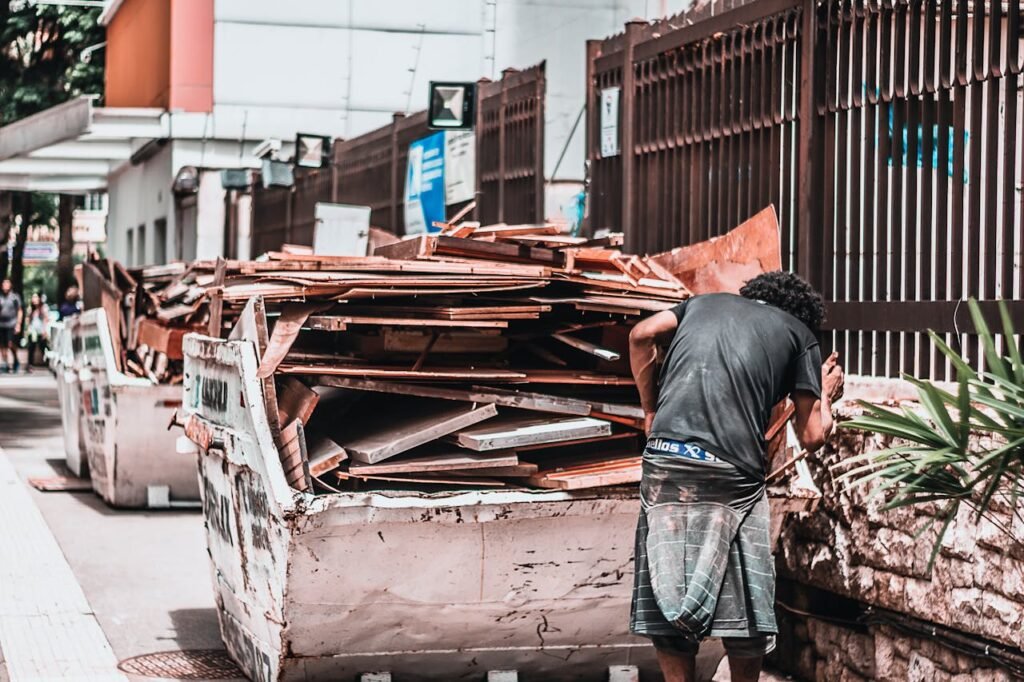Waste Wood Recycling Market Report Reveals Opportunities Outside Mainstream Recycling Headlines
Waste wood is quietly becoming one of the most interesting — and under-covered — corners of the circular-economy story. For years, wood removed from construction, urban tree work, furniture waste and packaging was treated as low-value material: chipped, incinerated, buried or used for low-grade fuel. That is changing. New market reports, municipal pilots, and university research reveal a patchwork of opportunities — from urban biochar and high-value reclaimed timber to engineered products and feedstocks for low-carbon industries — that could transform how cities and companies approach timber waste. According to Business Research Insights, the global wood recycling market was valued at approximately USD 23.62 billion in 2024 and is expected to continue showing steady growth.
The scale matters. National and international datasets now track bioenergy and wood-residue flows with much greater detail. According to FAO (FAOSTAT), a new bioenergy data release covering 1990–2023 offers better visibility into how much solid biofuel — including fuelwood and residues — is produced and used worldwide, and that transparency helps planners identify wasted value streams. A separate U.S. technical assessment, the 2023 Billion-Ton Report, provides tables that quantify energy potential in wood and wood-waste streams and shows these materials remain a significant, under-utilised resource for clean energy and materials strategies. Together, these research outputs put hard numbers behind what felt, until recently, like vague potential.

How Cities and Startups Turn Timber Trash into Value
The best way to understand what’s possible is to look at people making it happen. In Baltimore, a city program that salvages wood from vacant houses and urban tree removals has turned derelict timber into products sold locally — creating jobs while keeping wood out of landfills. The Baltimore Wood Project shows tangible social benefits: reclaimed timber becomes raw material for local furniture makers and small manufacturers rather than landfill cover. The World Economic Forum reported on this project as an urban circular economy model.
Across the Atlantic, researchers at University College London’s Circular Economy Lab built a pilot called CascadeUp that takes timber destined for demolition waste and prepares it for reuse in structural products: glued-laminated secondary timber (glulamST) and cross-laminated secondary timber (CLST). The pilot demonstrates that with careful sorting, product passports and manufacturing controls, wood from demolition can be upgraded into mass-timber components that offer a low-carbon alternative to concrete and steel. That’s not a fictional concept — it’s a tested, building-scale demonstration backed by university research.
Startups are part of the story, too. Urban Machine — a company building robotics and software to reclaim lumber from construction and demolition — has been piloting robotic deconstruction to recover usable boards at scale. Other small firms make artisanal furniture from salvaged beams, creating resilient local markets that value provenance and longevity. One example is Room & Board’s use of reclaimed wood for furniture lines; another is smaller social enterprises that train people with employment barriers to deconstruct buildings and process reclaimed timber. These businesses show the human side of circularity: jobs, skills and local income are created alongside material savings.
City-level biochar projects give a different, complementary example. The Carbon Neutral Cities Alliance produced a playbook that documents pilot projects in Boulder, Helsinki, Minneapolis and Stockholm using urban-tree removals and other woody residues to produce biochar. The scale of carbon and soil benefits varies by city, but the playbook reports potential annual CO2e reductions that, for Boulder, range from roughly 400 to 2,053 metric tons and in Helsinki from around 18,874 to 46,630 tons per year — using feedstock that would otherwise be chipped or burned. Those numbers are meaningful for municipal planners looking for near-term carbon action.
The Technologies and Market Pathways that are Emerging Now
The technologies turning waste wood into value are not one-size-fits-all. At one end are low-tech yet high-impact local approaches — careful deconstruction, sorting, and reuse as reclaimed lumber or second-use furniture. At the other end are higher-value engineered products and thermal-chemical routes: cross-laminated timber manufactured from reclaimed elements, pyrolysis to make biochar and bio-oils, and integration into composite materials (for example, wood waste into particleboard, or treated biochar as a soil amendment to improve water retention and nutrient recovery).
Research in peer-reviewed journals shows the benefits and caution points. A 2024 study on biochar produced from wood feedstocks found clear soil and nutrient-recovery benefits in trials and recommends attention to feedstock quality and production conditions. Pyrolysis studies focused on construction and demolition wood show the process can be robust and scalable when systems are designed for the specific feedstock mix.
Market signals are emerging, too. Commercial actors are waking up to the need for scale. According to Reuters, Ingka Group (the largest IKEA retailer) said it will invest €1 billion in recycling companies, explicitly identifying wood as a material of interest alongside textiles and plastics — a reminder that large buyers influence what recycling can scale. That commitment came with an explicit note about capacity shortages and the high carbon footprint of virgin materials; corporate capital can accelerate new recycling value chains if directed carefully.
Even widely used industrial materials are seeing wood-waste innovation. University and industry teams are testing biochar blends in stormwater systems, bioswales and even as partial replacements in construction mixes (biochar and ash substitutes), while other work explores reclaimed-timber CLT for structural use. Where a feedstock is paired with an application that values its properties (carbon storage, nutrient retention, aesthetics, or structural capacity), you get higher value than simply burning the wood for low-grade energy.

What Cities, Businesses, and Policymakers Should Do Next
There is no single silver bullet, but clear priorities emerge from successful pilots and market reports. First, get the numbers right: cities and companies need better inventories. FAO’s FAOSTAT bioenergy release and the U.S. Billion-Ton analysis show how visibility unlocks strategy — knowing how much wood you have and where it comes from lets planners choose reuse, biochar, or energy depending on the feedstock quality and local needs.
Second, prioritise high-value reuse before low-value disposal. The UCL CascadeUp project shows it is feasible to take timber slated for demolition and route it into mass timber products with product passports and quality checks; doing so preserves embedded carbon and creates local manufacturing jobs.
Third, design municipal biochar or pyrolysis programs where reclaimed timber quality is low or contaminated, or where soil improvement and carbon storage are municipal priorities. The Carbon Neutral Cities playbook outlines a pathway to pilot urban biochar programs, with realistic carbon and ecosystem gains observed in peer cities.
Fourth, use policy levers to create demand for recycled wood. Extended Producer Responsibility schemes, procurement rules that prefer reclaimed or recycled wood, and product-passport systems that track materials across life cycles help level the playing field against cheaper virgin materials. The investment signals from major buyers — for example, Ingka Group’s €1 billion recycling fund — will matter only if procurement and regulation create stable markets for recycled wood.
Fifth, invest in local businesses and skills that close the loop. Programs that train workers in deconstruction, sorting and timber remediation (as in Baltimore’s reclaimed-wood initiatives and multiple social enterprises) create social value on top of environmental gains. Use targeted grants and public-private partnerships to scale the “people” side of the circular timber economy.
Finally, pilot and measure. Start small, measure real outcomes (tonnes diverted, CO2e sequestered, jobs created, sellable product value), and iterate.
Conclusion: Actionable checklist for the first 12 months (summary):
- Map your wood waste flows and classify them by grade.
- Run a partner search: local reclaimers, mass-timber manufacturers, pyrolysis/biochar operators.
- Pilot a small deconstruction + reclaim project and track costs and yields.
- Talk to local procurement teams about specifying reclaimed content.
- Seek grant or corporate partnership funding to scale the pilot.
The quiet revaluation of wood waste is underway. Where mainstream headlines focus on plastics and electronics, timber quietly offers carbon, jobs and material-value opportunities that are well within reach for cities, builders and brands. The latest market reports and municipal playbooks suggest a clear fact: treat wood as an asset, not a problem, and you unlock a net-gain circular economy — economically and ecologically.







